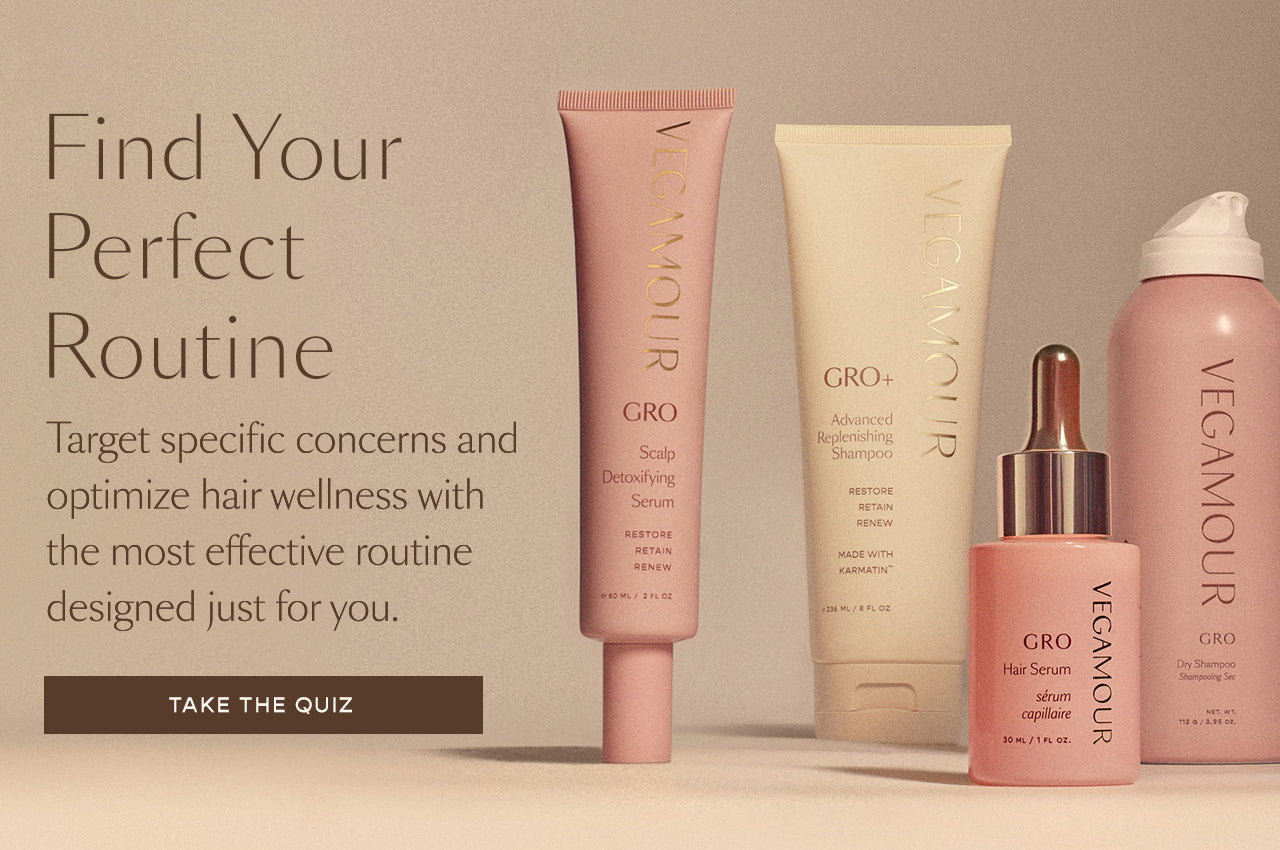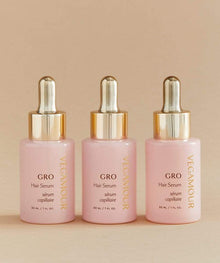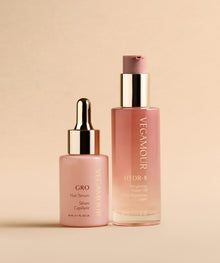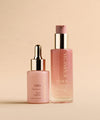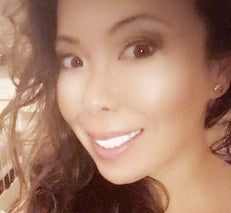The Best DHT Blockers to Grow Hair and Reduce Hair Loss
Hormonal hair loss is a hot topic. As we grow older, many of us begin noticing that our hair suddenly starts to look sparse or, worse yet, discover noticeable patches of hair loss along the hairline or scalp — and it’s not at all uncommon. In fact, hormonal hair loss often does occur later on in life.
If you’re noticing more and more hair tangled in your brush or around the house, you’re probably also Googling hair loss remedies. In your search, you may have stumbled across the acronym DHT or an enthusiastic suggestion to try DHT blockers as a treatment. That's because DHT, aka dihydrotestosterone, is one of the most influential elements related to hormonal hair loss.
Fortunately, there are plenty of options available to address DHT-induced thinning hair and hair loss. Read on for ways to hit the brakes on the loss of your hair by using DHT blockers — plus learn more about the products you should use to combat thinning hair.
What Is DHT?
Hair loss tends to become more prevalent as we age. This is because one of the triggers of hair loss is a result of the fluctuations in hormone levels. The hormone testosterone and its conversion into the molecule called DHT causes hair follicles to shrink. This can alter the hair growth cycle, potentially shortening the growth phase.
DHT is one of a few different androgen hormones that the human body produces. While both men and women produce androgens, which are necessary for a range of functions within the human body, men generally have more of them as they play a more critical role in their development.
DHT is integral for men’s sexual maturation and physical differentiation. Essentially, it is the hormone that makes men physically different from women. An androgen hormone is a sex hormone that contributes to the development of secondary sex characteristics in men.
DHT is derived from testosterone and contributes to traits such as:
- Increased body hair growth
- Increased muscle mass
- Deepening of the voice
- Changes in body fat distribution
- Improved sexual health, sex drive and/or fertility
- DHT is also involved in the enlargement of the prostate
Shop: Best Selling Products for Thinning Hair
How Is DHT Produced?
The production of DHT comes out of testosterone. Testosterone circulates through the body until it reaches areas where 5a-reductase is produced. This 5a-reductase is an enzyme that naturally occurs in certain human tissue and is responsible for the conversion of testosterone into the androgen hormone dihydrotestosterone (DHT). It serves as the catalyst for the conversion of testosterone into DHT.
Within the body, DHT works by binding to the androgen receptor. Once an androgen binds to the receptor, the receptor becomes activated, which is how DHT can have its effects.
And, unlike testosterone, DHT is much more clingy. It actually tends to stay put in the specific tissues where it was first created. These areas include:
- Male genitalia
- Brain
- Liver
- Skin
- Hair follicles
DHT and Hair Loss
DHT contributes to the development of secondary sex characteristics in men, such as body hair and hair growth from the scalp. Conversely, it can also cause hair loss to happen at a quicker and/or earlier rate. Its concentration in the skin, scalp hair and hair follicles, in particular, can lead to two seemingly contradictory effects — the growth of body hair and the loss of hair on the head, which is also known as male pattern baldness or androgenic alopecia.
Now that you understand how DHT ends up concentrated in the follicles, it’s time to explore just how it can play a role in hair loss, thinning hair, hair growth and regrowth. Having too much DHT flowing freely flowing through your bloodstream may link to the receptors on hair follicles in your scalp. In turn, this causes hair follicles to shrink and may shift how fast hair grows.
Once it has activated the androgen receptors in the hair follicles in the scalp, DHT actually shrinks them, and, as a result, it progressively shortens the hair growth cycle. This may lead to other issues such as hair thickness that isn't quite what it used to be or hair that falls out more quickly, feels brittle and looks dry or damaged. This is also the reason why, over time, hair loss and its effects grow worse. It's best to deal with it early on, rather than wait until it gets unbearably bad.
Boost Hair Health by Blocking DHT
If you think DHT is causing your hair loss woes, don't panic — there are ways to incorporate a DHT blocker into your regular hair care routine. These include both prescription medications, as well as more natural or over-the-counter remedies, such as adding a topical product like a hair serum.
Various treatments are used to suppress DHT in order to promote healthy, natural hair growth. These treatments are usually called either DHT inhibitors or DHT blockers. The principle behind almost all of them sounds counterintuitive and does not eliminate DHT. Rather, the way the majority of DHT blockers work is to stop the 5a-reductase catalyst from turning more testosterone into DHT. The goal is that, over time, the DHT levels in the body go back down, effectively reducing or reversing hair loss.
Among the most common ingredients found in medicinal DHT blockers prescribed by doctors are finasteride and minoxidil.
About Finasteride
Finasteride, which is also known as Propecia, is an oral prescription drug that was created to shrink an enlarged prostate. It also targets DHT and its attack on the hair follicles. Some people, however, may experience serious side effects when taking finasteride. For example, it may cause enlargement of the prostate.
About Minoxidil
Minoxidil, aka Rogaine, is a topical agent and is the only FDA-approved treatment for female hair loss. The most common side effects of minoxidil are skin irritation and itching. However, more serious side effects include headaches, dizziness, chest pain or increased or decreased blood pressure.
Minoxidil is known as a vasodilator, which means that it makes the blood vessels widen in order to create more expansive blood flow. It was originally used for high blood pressure, but it also may expand hair follicles that have shrunk in the presence of DHT, which can allow for improved hair thickness or density. Additionally, increased blood flow can help with overall circulation, improving scalp health.
Related: What Medications Can Cause Hair Loss?
Pick Plant-Powered Products
If natural hair loss treatments are more your speed, go with the power of plants — aka nature's medicine!
Plant-powered ingredients are a great option for thinning hair, including:
- Red clover, which can be found in GRO Hair Serum
- Biotin
- Pumpkin seed oil
- Saw palmetto

These hair loss treatment options utilize natural ingredients that can inhibit DHT and allow you to address hair issues without the serious side effects of prescription medication. Here's more about each one.
Red Clover
Red clover, when used in combination with oligopeptide-2, is one of those ingredients that may be effective for reversing hair loss caused by DHT when applied directly to the scalp, according to one study.
Biotin
A daily biotin supplement is a great way to ensure you're getting the nutrients you need to support healthy hair. It includes folic acid, zinc and other hair-beneficial vitamins and minerals, is another plant-powered way to bolster both your hair and overall health.
Pumpkin Seed Oil
First, there's pumpkin seed oil. Its topical application has been found to promote hair growth by blocking the 5-alpha reductase enzyme in order to inhibit DHT. According to one study, mean hair count increases of 40% were observed in PSO-treated men after 24 weeks, while gains of 10% were observed in the placebo group. That said, scientific research on this ingredient for hair loss has been fairly minimal.
Saw Palmetto
Next up is saw palmetto, a small palm tree with a fruit that has remarkable effects. When consumed, saw palmetto acts as a DHT-blocker. Some research suggests that saw palmetto extract may block 5 alpha-reductase. Saw palmetto prevents the conversion of testosterone into DHT to promote hair growth and has anti-inflammatory properties. Inflammation in hair follicles or the scalp can cause hair growth problems.
Also: 6 Foods That May Block DHT
How DHT Affects Women
Hair loss in women is nearly as prevalent as it is in men: 40% of people who struggle with hair loss are women, according to the American Hair Loss Association. But DHT-induced hair loss in women is different from male pattern hair loss. Men usually end up with a receding hairline, a bald patch at the crown or complete balding of the scalp. As men have more testosterone than women do, balding is more common. This is seen in the M-shaped pattern of thinning hair, known as male pattern baldness. In women, the thinning hair tends to occur all over the scalp.
Try: GRO Dry Shampoo
Menopause and Medical Concerns
For women, hormonal hair loss usually goes hand-in-hand along with dramatic hormonal shifts, such as menopause, and manifests as a loss of hair density, which can be embarrassing and all the more stressful. During menopause, it’s not necessarily correlated with an increase of DHT in the body. What actually happens is that the body is producing fewer female hormones like estrogen and progestin. And, as a result, androgen receptors become more sensitive.
Among postmenopausal women, as many as two-thirds suffer from hair thinning or hair loss, according to Harvard Medical School. Women can also experience an increase in DHT if their body produces more testosterone because of a specific endocrine (i.e., hormonal) health condition like polycystic ovary syndrome or if they develop an androgen-secreting tumor.
In these examples, hair loss in women can actually be a sign of more serious underlying medical conditions. As with other health conditions, if your symptoms are concerning you, head to your doctor to discuss treatment options.
Related: How To Minimize Hair Loss From Stress
Happy, Healthy Hair Habits
Pattern hair loss, like other physical changes, can be scary, but now that you understand the science behind it, you can begin dealing with it. Natural DHT blockers might be just the solution you need to combat thinning hair.
Hit the reset button and set your tresses up for success by adding other healthy habits into your lifestyle. These include reducing stress, eating a balanced diet, staying hydrated, sticking with a healthy sleep cycle, practicing yoga for hair loss and integrating self-care — along with self-love — into your daily routine.
More From VEGAMOUR
- Shop: Shea Whitney's Top VEGAMOUR Picks
- Is It Safe to Take Prenatal Vitamins for Hair Growth?
- What You Should Know About Traction Alopecia
- Spironolactone Side Effects Explained
